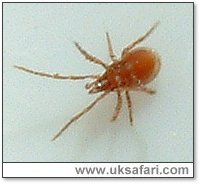
|

|
|
 Sent
to you Sent
to you
by e-mail
|
|
Simply
enter your details and hit the send button
more
info |
|


Click Here

Links
Advertise
Terms of Use
Contributors
About Us
Contact Us
|
 |
Go back
 | Bookmark
| Bookmark
 | Print Page
| Print Page  | E-Mail Us
| E-Mail Us 
 The Life Cycle of the Tick
The Life Cycle of the Tick

Photo: G. Bradley |
|
UK
Safari Tip:
You can see all the details on ticks and other tiny creatures with the
help of a powerful hand lens - click
here
|
|
Many ticks go through a three host life cycle, meaning that they parasite three different host bodies during their
lifetime.
A tick starts life as an egg, and because tick mortality is so high, the female tick lays as many as 18,000 eggs in the ground.
The tick egg hatches out into a larva. The larva has only six legs. It stays hidden in leaf litter until the following spring, when
it climbs up vegetation and waves its legs around hoping to latch onto a passing host, such as a bird or mammal. Being warm blooded, the host is detected by the heat it gives off.
When it is fully fed the larva drops to the ground and moults into a nymph. The nymphs (and the adults) have 8 legs. The nymph then climbs onto another host.
Again, when it is fully fed it drops to the ground, moults into an adult tick and climbs onto its final host. Mating can take place on the host, and when the female has been fertilised she drops to the ground to lay her eggs. The male dies shortly after mating.

The UK Safari Tick Page
What's Lyme Disease?
How to Safely Remove a Tick
UK Safari Creepy-Crawlies Section
|
 |

|